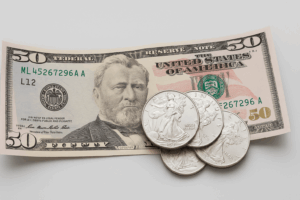Gold Retreats After Trump-Fed Showdown
Gold prices pulled back Tuesday, settling around $3,340/oz after Monday’s spike that saw the metal briefly touch $3,370. The initial rally came as President Trump moved to oust Federal Reserve Governor Lisa Cook, sending traders scrambling for safe havens. Cook, one of the Fed’s three sitting governors, has been a vocal advocate for maintaining the central bank’s independence. But the dust is settling, and investors are now questioning whether this political theater will actually change monetary policy or if it’s just another round of Washington saber-rattling.
When politicians pressure the Fed, markets get nervous — and for good reason. Any crack in central bank independence could reignite inflation fears, which ironically would likely push gold higher over the long haul.
Trump Doubles Down on India Tariffs
The White House just cranked tariffs on Indian imports to 50%, punishing New Delhi for continuing to buy Russian oil. The move affects roughly $75 billion in annual trade and targets everything from textiles to pharmaceuticals. India is threatening to hit back, putting billions in U.S. exports on the chopping block — aerospace parts, agricultural products, and chemicals are all potential targets. Prime Minister Modi called the tariffs “deeply concerning” and warned they could derail years of improving U.S.-India relations.
This matters because India is both a major U.S. trading partner and one of the world’s biggest gold buyers. Trade wars have a nasty habit of weakening currencies and driving inflation, often sending Indian investors rushing to gold as protection. If history is any guide, escalating tensions could mean stronger gold demand from the world’s second-most populous nation.
Vietnamese Government Opens its Gold Market
After decades of state control, Vietnam is throwing open its gold industry to private and foreign companies. The government hopes competition will attract investment, clean up the market, and crack down on smuggling that’s plagued the sector for years. Currently, the state-run Saigon Jewelry Company (SJC) controls all official gold bar production, creating a black market worth an estimated $2-3 billion annually. The reforms, set to take effect in early 2026, will allow licensed private firms to produce and trade gold bars for the first time.
Vietnam’s gold market is massive — and it’s not just about investment. Gold is woven into the culture there, from wedding gifts to wealth preservation. Opening the floodgates could fundamentally reshape how gold flows through Asia and potentially ripple through global prices.
How Fed Drama Could Fuels a Precious Metals Run
Both gold and silver are riding high this week as the Fed drama unfolds. Silver touched nearly $42/oz, its best level in over a decade, while gold briefly topped $3,370/oz before consolidating. Saxo Bank analysts say Trump’s attempt to fire a Fed governor has investors worried about the central bank’s independence, with many drawing parallels to the Nixon era. Trading volumes in gold futures jumped 40% above the monthly average on Monday. All eyes now turn to Friday’s PCE inflation data, which could cement expectations for a September rate cut.
Here’s what’s spooking traders: political meddling with the Fed brings back memories of 1970s-style inflation. In that environment, precious metals become the go-to hedge — and that’s exactly what we’re seeing play out right now.
Old Solar Panels Become Silver Goldmines
A new recycling breakthrough could turn the world’s growing pile of dead solar panels into a lucrative source of silver. Researchers have developed technology that extracts up to 98% of the silver from defunct panels — metal that’s currently worth about $15 per panel and often ends up in landfills. Each standard solar panel contains about 20 grams of silver, used in the conductive paste that channels electricity. With 80 million tons of solar waste expected by 2050, we’re looking at a potential silver stockpile worth billions. The new process uses a combination of thermal and chemical treatments that’s both cheaper and cleaner than current methods.
Solar panels contain more silver than most people realize, and we’re about to have mountains of them to recycle. This unexpected supply source could put downward pressure on silver prices long-term — unless, of course, industrial demand keeps pace with the solar boom that created all this waste in the first place. It’s a classic case of one industry’s trash becoming another’s treasure.





